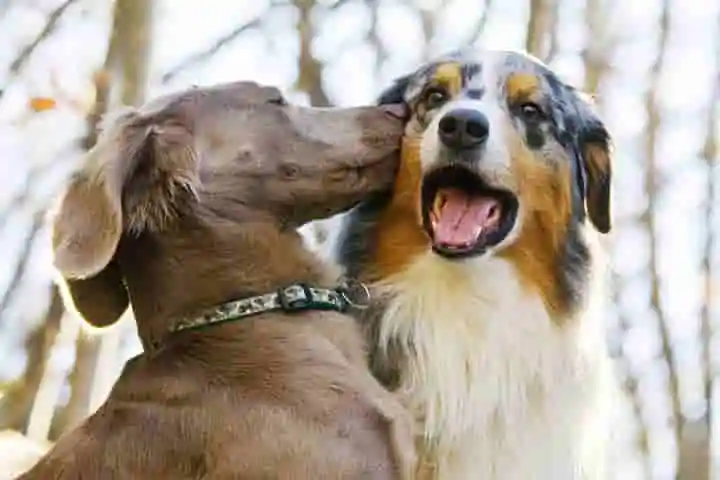

Dogs like human beings exhibit hyperactive impulsive behaviour and inattention (Pic. Courtesy pets.webmd.com)
<p>
<strong>Considered to be the closest companion of human beings among all the animals, dogs also share some common traits with us. Revealing this is a study that was recently conducted involving nearly 11,000 dogs that showed that characteristics like hyperactive impulsive behaviour and inattention (ADHD) are connected to the animal&rsquo;s age, breed, and gender and also behavioural problems and certain environmental factors.</strong></p>
<p>
In an article in sciencedaily.com, Professor Hannes Lohi, University of Helsinki&rsquo;s head of canine research group stated: <a href="https://www.sciencedaily.com/releases/2021/10/211015184215.htm">&quot;Our findings can help to better identify, understand and treat canine h</a>yperactivity, impulsivity and inattention. Moreover, they indicated similarity with human ADHD, consolidating the role of dogs in ADHD-related research.&rdquo;</p>
<p>
Shedding light on the human-dog connection, Sini Sulkama, a doctoral researcher remarked: &quot;Dogs share many similarities with humans, including physiological traits and the same environment. In addition, ADHD-like behaviour naturally occurs in dogs. This makes dogs an interesting model for investigating ADHD in humans.&rdquo;</p>
<p>
The researchers led by Professor Lohi gathered for this study data of more than 11,000 dogs by doing a behavioural survey that was extensive. In this hyperactivity, impulsivity and inattention were studied and for that questions used for ADHD research of humans were used. The study aimed to connect environmental factors that are basic to ADHD-like behaviour in canines.</p>
<p>
Talking about the study, Jenni Puurunen, PhD said: &quot;We found that hyperactivity, impulsivity and inattention were more common in young dogs and male dogs. Corresponding observations relating to age and gender in connection with ADHD have been made in humans too.&rdquo;</p>
<p>
<strong>Also read: <a href="https://www.indianarrative.com/science-news/siberian-dogs-reveal-secret-of-ancient-trade-links-between-snowy-arctic-and-the-caspian-sea-120980.html">Siberian dogs reveal secret of ancient trade links between snowy Arctic and the Caspian Sea</a></strong></p>
<p>
It was found that dogs who were alone most of the time at home had the traits of being impulsive, inattentive and hyperactive than those animals who were not alone.</p>
<p>
Giving reasons for this Sulkama said: &quot;As social animals, dogs can get frustrated and stressed when they are alone, which can be released as hyperactivity, impulsivity and inattention. It may be that dogs who spend longer periods in solitude also get less exercise and attention from their owners.&rdquo;</p>
<p>
Experience of the owner too played a vital role in the canine&rsquo;s hyperactivity and impulsivity as these characteristics were found to be common in those animals who were not their owner&rsquo;s first dogs. The cause of this was not clear.</p>
<p>
It was also discovered that breeding played a major role in behaviour that is breed-specific while the divergence in the breeds also points at the genes that dictate these relevant traits.</p>
<p>
<strong>Also read: <a href="https://www.indianarrative.com/science-news/domestic-cats-hunt-to-satisfy-their-killer-instinct-and-not-for-food-119153.html">Domestic Cats Hunt To Satisfy Their Killer Instinct And Not For Food</a></strong></p>
<p>
Explaining this Lohi said: &quot;Hyperactivity and impulsivity on the one hand, and good concentration on the other, are common in breeds bred for work, such as the German Shepherd and Border Collie. In contrast, a more calm disposition is considered a benefit in breeds that are popular as pets or show dogs, such as the Chihuahua, Long-Haired Collie and Poodle, making them easier companions in everyday life. Then again, the ability to concentrate has not been considered as important a trait in these breeds as in working breeds, which is why inattention can be more common among pet dogs.&rdquo;</p>
<p>
The research also authenticated what had been observed in the past &ndash; the association of hyperactivity, impulsivity and inattention, and obsessive-compulsive behaviour, aggressiveness and fearfulness. For example, obsessive-compulsive disorder (OCD) happens in combination with ADHD. In the case of these canines this manifests as tail chasing, continuous licking of surfaces or themselves, or staring at &#39;nothing&#39;.</p>
<p>
Summing up the study succinctly Sulkama said: &quot;The findings suggest that the same brain regions and neurobiological pathways regulate activity, impulsivity and concentration in both humans and dogs. This strengthens the promise that dogs show as a model species in the study of ADHD. In other words, the results can both make it easier to identify and treat canine impulsivity and inattention as well as promote ADHD research.&rdquo;</p>
Panama's Foreign Minister Javier Martinez Acha on Thursday backed India for a permanent seat in…
US Congressmen Raja Krishnamoorthi opposed the Donald Trump administration for freezing student visa interviews amid…
A grand welcome celebration for Ayodhya Shri Ram Lalla was organized by the Ayodhya Shri…
The Foundation stone for the construction of the Agriculture Promotion Centre for Food Grains Collection…
External Affairs Minister S Jaishankar said that the relationship, connect and empathy between India and…
The Baloch National Movement (BNM) held a protest outside the Embassy of Pakistan in The…